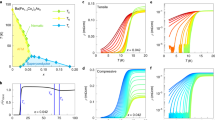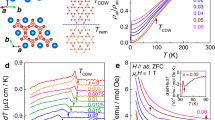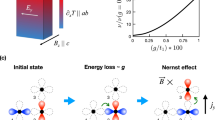Abstract
The electronic nematic phase—in which electronic degrees of freedom lower the crystal rotational symmetry—is commonly observed in high-temperature superconductors. However, understanding the role of nematicity and nematic fluctuations in Cooper pairing is often made more complicated by the coexistence of other orders, particularly long-range magnetic order. Here we report the enhancement of superconductivity in a model electronic nematic system that is not magnetic, and show that the enhancement is directly born out of strong nematic fluctuations associated with a quantum phase transition. We present measurements of the resistance as a function of strain in Ba1−xSrxNi2As2 to show that strontium substitution promotes an electronically driven nematic order in this system. In addition, the complete suppression of that order to absolute zero temperature leads to an enhancement of the pairing strength, as evidenced by a sixfold increase in the superconducting transition temperature. The direct relation between enhanced pairing and nematic fluctuations in this model system, as well as the interplay with a unidirectional charge-density-wave order comparable to that found in the cuprates, offers a means to investigate the role of nematicity in strengthening superconductivity.
This is a preview of subscription content, access via your institution
Access options
Access Nature and 54 other Nature Portfolio journals
Get Nature+, our best-value online-access subscription
$29.99 / 30 days
cancel any time
Subscribe to this journal
Receive 12 print issues and online access
$209.00 per year
only $17.42 per issue
Buy this article
- Purchase on Springer Link
- Instant access to full article PDF
Prices may be subject to local taxes which are calculated during checkout




Similar content being viewed by others
References
Orenstein, J. & Millis, A. J. Advances in the physics of high-temperature superconductivity. Science 288, 468–474 (2000).
Keimer, B., Kivelson, S. A., Norman, M. R., Uchida, S. & Zaanen, J. From quantum matter to high-temperature superconductivity in copper oxides. Nature 518, 179–186 (2015).
Paglione, J. & Greene, R. High-temperature superconductivity in iron-based materials. Nat. Phys. 6, 645–658 (2010).
Johnston, D. C. The puzzle of high temperature superconductivity in layered iron pnictides and chalcogenides. Adv. Phys. 59, 803–1061 (2010).
Stewart, G. R. Superconductivity in iron compounds. Rev. Mod. Phys. 83, 1589–1652 (2011).
Fernandes, R. M., Chubukov, A. V. & Schmalian, J. What drives nematic order in iron-based superconductors? Nat. Phys. 10, 97–104 (2014).
Kivelson, S., Fradkin, E. & Emery, V. Electronic liquid crystal phases of a doped Mott insulator. Nature 393, 550–553 (1998).
Chu, J.-H., Kuo, H.-H., Analytis, J. G. & Fisher, I. R. Divergent nematic susceptibility in an iron arsenide superconductor. Science 337, 710–712 (2012).
Kuo, H.-H., Chu, J.-H., Palmstrom, J. C., Kivelson, S. A. & Fisher, I. R. Ubiquitous signatures of nematic quantum criticality in optimally doped Fe-based superconductors. Science 352, 958–962 (2016).
Metlitski, M. A., Mross, D. F., Sachdev, S. & Senthil, T. Cooper pairing in non-Fermi liquids. Phys. Rev. B 91, 115111 (2015).
Lederer, S., Schattner, Y., Berg, E. & Kivelson, S. A. Enhancement of superconductivity near a nematic quantum critical point. Phys. Rev. Lett. 114, 097001 (2015).
Lederer, S., Schattner, Y., Berg, E. & Kivelson, S. A. Superconductivity and non-Fermi liquid behavior near a nematic quantum critical point. Proc. Natl Acad. Sci. USA 114, 4905–4910 (2017).
Kang, J. & Fernandes, R. M. Superconductivity in FeSe thin films driven by the interplay between nematic fluctuations and spin–orbit coupling. Phys. Rev. Lett. 117, 217003 (2016).
Klein, A., Wu, Y. & Chubukov, A.V. Multiple intertwined pairing states and temperature-sensitive gap anisotropy for superconductivity at a nematic quantum-critical point. npj Quantum Mater. 4, 55 (2019).
Hinkov, V. et al. Electronic liquid crystal state in the high-temperature superconductor YBa2Cu2O2. Science 319, 597–600 (2008).
Vojta, M. Lattice symmetry breaking in cuprate superconductors: stripes, nematics, and superconductivity. Adv. Phys. 58, 699–820 (2009).
Sato, Y. et al. Thermodynamic evidence for a nematic phase transition at the onset of the pseudogap in YBa2Cu2O2. Nat. Phys. 13, 1074–1078 (2017).
Hosoi, S. et al. Nematic quantum critical point without magnetism in FeSe1−xS1−x superconductor. Proc. Natl Acad. Sci. USA 113, 8139–8143 (2016).
Reiss, P. et al. Suppression of electronic correlations by chemical pressure from FeSe to FeS. Phys. Rev. B 96, 121103 (2017).
Yamakawa, Y., Onari, S. & Kontani, H. Zigzag chain structure transition and orbital fluctuations in Ni-based superconductors. J. Phys. Soc. Jpn 82, 094704 (2013).
Ronning, F. et al. The first order phase transition and superconductivity in BaNi2As2 single crystals. J. Phys. Condens. Matter 20, 342203 (2008).
Sefat, A. S. et al. Structure and anisotropic properties of BaFe2−xNi2−xAs2−x (x = 0, 1, and 2) single crystals. Phys. Rev. B 79, 094508 (2009).
Kothapalli, K., Ronning, F., Bauer, E. D., Schultz, A. J. & Nakotte, H. Single-crystal neutron diffraction studies on Ni-based metal-pnictide superconductor BaNi2As2. J. Phys. Conf. Ser. 251, 012010 (2010).
Lee, S. et al. Unconventional charge density wave order in the pnictide superconductor Ba(Ni1−xCo1−x)1−xAs1−x. Phys. Rev. Lett. 122, 147601 (2019).
Bauer, E. D., Ronning, F., Scott, B. L. & Thompson, J. D. Superconductivity in SrNi2As2 single crystals. Phys. Rev. B 78, 172504 (2008).
Subedi, A. & Singh, D. J. Density functional study of BaNi2As2: electronic structure, phonons, and electron–phonon superconductivity. Phys. Rev. B 78, 132511 (2008).
Kurita, N. et al. Low-temperature magnetothermal transport investigation of a Ni-based superconductor BaNi2As2: evidence for fully gapped superconductivity. Phys. Rev. Lett. 102, 147004 (2009).
Kudo, K., Takasuga, M., Okamoto, Y., Hiroi, Z. & Nohara, M. Giant phonon softening and enhancement of superconductivity by phosphorus doping of BaNi2As2. Phys. Rev. Lett. 109, 097002 (2012).
Kudo, K., Takasuga, M. & Nohara, M. Copper doping of BaNi2As2: giant phonon softening and superconductivity enhancement. Preprint at http://arXiv.org/abs/1704.04854 (2017).
Eckberg, C. et al. Evolution of structure and superconductivity in Ba(Ni1−xCo1−x)1−xAs1−x. Phys. Rev. B 97, 224505 (2018).
Cano, A., Civelli, M., Eremin, I. & Paul, I. Interplay of magnetic and structural transitions in iron-based pnictide superconductors. Phys. Rev. B 82, 020408 (2010).
Fernandes, R. M., Chubukov, A. V., Knolle, J., Eremin, I. & Schmalian, J. Preemptive nematic order, pseudogap, and orbital order in the iron pnictides. Phys. Rev. B 85, 024534 (2012).
Fernandes, R. M., Böhmer, A. E., Meingast, C. & Schmalian, J. Scaling between magnetic and lattice fluctuations in iron pnictide superconductors. Phys. Rev. Lett. 111, 137001 (2013).
Achkar, A. J. et al. Nematicity in stripe-ordered cuprates probed via resonant x-ray scattering. Science 351, 576–578 (2016).
Nie, L., Tarjus, G. & Kivelson, S. A. Quenched disorder and vestigial nematicity in the pseudogap regime of the cuprates. Proc. Natl Acad. Sci. USA 111, 7980–7985 (2014).
Johnston, D. C. Elaboration of the α-model derived from the BCS theory of superconductivity. Supercond. Sci. Technol. 26, 115011 (2013).
Yonezawa, S., Higuchi, T., Sugimoto, Y., Sow, C. & Maeno, Y. Compact AC susceptometer for fast sample characterization down to 0.1 K. Rev. Sci. Instrum. 86, 093903 (2015).
Shapiro, M. C., Hristov, A. T., Palmstrom, J. C., Chu, J.-H. & Fisher, I. R. Measurement of the B 1g and B 2g components of the elastoresistivity tensor for tetragonal materials via transverse resistivity configurations. Rev. Sci. Instrum. 87, 063902 (2016).
Shapiro, M. C., Hlobil, P., Hristov, A. T., Maharaj, A. V. & Fisher, I. R. Symmetry constraints on the elastoresistivity tensor. Phys. Rev. B 92, 235147 (2015).
Acknowledgements
Research at the University of Maryland was supported by the AFOSR Grant No. FA9550-14-10332, the National Science Foundation Grant No. DMR1905891, and the Gordon and Betty Moore Foundation’s EPiQS Initiative through Grant No. GBMF4419. We also acknowledge support from the Maryland Quantum Materials Center as well as the Maryland Nanocenter and its FabLab. The identification of any commercial product or trade name does not imply endorsement or recommendation by the National Institute of Standards and Technology. Theory work (R.M.F. and M.H.C.) was supported by the US Department of Energy, Office of Science, Basic Energy Sciences under award number DE-SC0012336. X-ray experiments at UIUC were supported by DOE grant DE-FG02-06ER46285. P.A. acknowledges support from the Gordon and Betty Moore Foundation’s EPiQS initiative through grant GBMF4542.
Author information
Authors and Affiliations
Contributions
C.E. and J.P. conceived and designed the experiments. C.E., D.J.C., T.M., H.H. and T.D. synthesized crystals and performed basic physical characterization. C.E. performed elastoresistivity measurements. J.C., S.L. and P.A. performed and analysed low-temperature X-ray characterization of the CDW phase. P.Z. performed and analysed 250 K single-crystal X-ray diffraction. J.L. performed preliminary neutron diffraction studies. M.H.C. and R.M.F. developed the phenomenological model describing the evolution of nematicity in this system. C.E., J.P., R.M.F. and M.H.C. wrote the manuscript with contributions from all authors.
Corresponding authors
Ethics declarations
Competing interests
The authors declare no competing interests.
Additional information
Peer review information Nature Physics thanks Dimitri Basov and the other, anonymous, reviewer(s) for their contribution to the peer review of this work.
Publisher’s note Springer Nature remains neutral with regard to jurisdictional claims in published maps and institutional affiliations.
Supplementary information
Supplementary Information
Additional theoretical discussion and experimental data, Supplementary Figs. 1–12 and refs. 1–3.
Source data
Source data Fig 1
Source data for Figure 1
Source data Fig 2
Source data for Figure 2
Source data Fig 3
Source data for Figure 3
Source data Fig 4
Source data for Figure 4
Rights and permissions
About this article
Cite this article
Eckberg, C., Campbell, D.J., Metz, T. et al. Sixfold enhancement of superconductivity in a tunable electronic nematic system. Nat. Phys. 16, 346–350 (2020). https://doi.org/10.1038/s41567-019-0736-9
Received:
Accepted:
Published:
Issue Date:
DOI: https://doi.org/10.1038/s41567-019-0736-9
This article is cited by
-
Precursor region with full phonon softening above the charge-density-wave phase transition in 2H-TaSe2
Nature Communications (2023)
-
Optimized superconductivity in the vicinity of a nematic quantum critical point in the kagome superconductor Cs(V1-xTix)3Sb5
Nature Communications (2023)
-
An electronic nematic liquid in BaNi2As2
Nature Communications (2022)
-
Elastoresistivity in the incommensurate charge density wave phase of BaNi2(As1−xPx)2
npj Quantum Materials (2022)
-
Dynamics of collective modes in an unconventional charge density wave system BaNi2As2
Communications Physics (2022)



